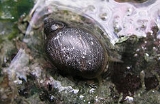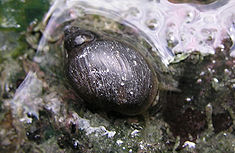
Cave and Basin National Historic Site
Encyclopedia
The Cave and Basin National Historic Site of Canada is located in the town of Banff, Alberta
within the Canadian Rocky Mountains, at the site of natural thermal mineral springs
around which Canada's first national park, Banff National Park
, was established.
below Devonian limestones. The water is heated geothermally from an estimated depth of three kilometres. The Cave and Basin is the only underground cavern
large enough to comfortably accommodate groups of people.
of the Palliser Expedition
in 1859, followed by Joe Healey in 1874 who found the Cave and Basin site in 1875. But it was Canadian Pacific Railway
workers William McCardell and Frank McCabe who brought national attention to the Cave and Basin. In 1883 they descended through the skylight entrance into the cave using a felled tree, and the following year constructed a small cabin nearby with the intention of commercializing the Cave and Basin site. Conflicting claims by other parties prompted intervention by the Canadian government headed by John A. Macdonald
and in 1885 an order-in-council reserved 10 square miles (25.9 km²) around the Cave and Basin, the Banff Hot Springs Reserve. This was the genesis of Canada's National Parks system. In 1886 the Canadian government held an inquiry into the various private claims to settle on compensation.
In 1886 an artificial tunnel was driven into the Cave and Basin to aid visitation. In 1912 bottled water from the Cave and Basin site was sold for its alleged curative powers. In 1914 a naturally heated swimming pool was opened to the public and continued to operate until 1994.
The Cave and Basin was formally declared a national historic site in 1981. Canada's national parks system celebrated its centennial in 1985, on the anniversary of the order-in-council that established the original reserve around the Cave and Basin.
. The pools were closed in 1975, restored in 1985, then closed again in 1992. An interpretive center now uses the structures. The 1954 caretaker's residence is now used as a tea house. The Banff Upper Hot Springs is a separate facility some 5 km (3 mi) southeast of the Cave and Basin.
Many of the early structures were built by detainees held at a World War I
internment camp located nearby. The camp held citizens of countries with which Canada was at war at the time, and had a significant Ukrainian contingent.
 Almost all of the delicate cave formations had been stripped out of the Cave and Basin immediately following its 'discovery'. According to articles in the Calgary Herald
Almost all of the delicate cave formations had been stripped out of the Cave and Basin immediately following its 'discovery'. According to articles in the Calgary Herald
at the time, the construction of the artificial tunnel was contentious even in 1887. In 1924 Western Mosquitofish were introduced into the hot springs in an attempt to control mosquitos. Tropical fish illegally introduced into the lower springs by local aquarium enthusiasts may have contributed to the extinction of the Banff Longnose Dace
. Cave and Basin hot springs are also notable as the habitat for the Banff Springs snail
, listed as an endangered species
in 2000 by the Committee on the Status of Endangered Wildlife in Canada
.
Banff, Alberta
Banff is a town within Banff National Park in Alberta, Canada. It is located in Alberta's Rockies along the Trans-Canada Highway, approximately west of Calgary and east of Lake Louise....
within the Canadian Rocky Mountains, at the site of natural thermal mineral springs
Hot spring
A hot spring is a spring that is produced by the emergence of geothermally heated groundwater from the Earth's crust. There are geothermal hot springs in many locations all over the crust of the earth.-Definitions:...
around which Canada's first national park, Banff National Park
Banff National Park
Banff National Park is Canada's oldest national park, established in 1885 in the Rocky Mountains. The park, located 110–180 kilometres west of Calgary in the province of Alberta, encompasses of mountainous terrain, with numerous glaciers and ice fields, dense coniferous forest, and alpine...
, was established.
Geology and setting
The Cave and Basin is the lowest component of nine sulphurous hot springs clustered in three groups on the northeast flank of Sulphur Mountain. All are located along the Sulphur Mountain Thrust FaultThrust fault
A thrust fault is a type of fault, or break in the Earth's crust across which there has been relative movement, in which rocks of lower stratigraphic position are pushed up and over higher strata. They are often recognized because they place older rocks above younger...
below Devonian limestones. The water is heated geothermally from an estimated depth of three kilometres. The Cave and Basin is the only underground cavern
Cave
A cave or cavern is a natural underground space large enough for a human to enter. The term applies to natural cavities some part of which is in total darkness. The word cave also includes smaller spaces like rock shelters, sea caves, and grottos.Speleology is the science of exploration and study...
large enough to comfortably accommodate groups of people.
History
Human habitation in this area can be traced back to 10,700 years BP with the retreat of the last great glaciation, and it is unlikely that the hot springs escaped their notice. The first recorded reference to hot springs here is by James HectorJames Hector
Sir James Hector was a Scottish geologist, naturalist, and surgeon who accompanied the Palliser Expedition as a surgeon and geologist...
of the Palliser Expedition
Palliser Expedition
The British North American Exploring Expedition, commonly called the Palliser Expedition, explored and surveyed the open prairies and rugged wilderness of western Canada from 1857 to 1860. The purpose was to explore possible routes for the Canadian Pacific Railway and discover new species of plants...
in 1859, followed by Joe Healey in 1874 who found the Cave and Basin site in 1875. But it was Canadian Pacific Railway
Canadian Pacific Railway
The Canadian Pacific Railway , formerly also known as CP Rail between 1968 and 1996, is a historic Canadian Class I railway founded in 1881 and now operated by Canadian Pacific Railway Limited, which began operations as legal owner in a corporate restructuring in 2001...
workers William McCardell and Frank McCabe who brought national attention to the Cave and Basin. In 1883 they descended through the skylight entrance into the cave using a felled tree, and the following year constructed a small cabin nearby with the intention of commercializing the Cave and Basin site. Conflicting claims by other parties prompted intervention by the Canadian government headed by John A. Macdonald
John A. Macdonald
Sir John Alexander Macdonald, GCB, KCMG, PC, PC , QC was the first Prime Minister of Canada. The dominant figure of Canadian Confederation, his political career spanned almost half a century...
and in 1885 an order-in-council reserved 10 square miles (25.9 km²) around the Cave and Basin, the Banff Hot Springs Reserve. This was the genesis of Canada's National Parks system. In 1886 the Canadian government held an inquiry into the various private claims to settle on compensation.
In 1886 an artificial tunnel was driven into the Cave and Basin to aid visitation. In 1912 bottled water from the Cave and Basin site was sold for its alleged curative powers. In 1914 a naturally heated swimming pool was opened to the public and continued to operate until 1994.
The Cave and Basin was formally declared a national historic site in 1981. Canada's national parks system celebrated its centennial in 1985, on the anniversary of the order-in-council that established the original reserve around the Cave and Basin.
Facilities
The built facilities include an artificial tunnel to natural grotto, a replica of the original 1887 bathhouse, the restored 1916 swimming pool and structure, interpretive displays, hiking and snowshoe trails. The 1887 bathhouse, the first structure on the site, proved inadequate by 1902, and a new pool was built in 1904. The stone bathhouse was completed in 1914, designed by architect Walter S. PainterWalter S. Painter
Walter S. Painter was an American architect who is chiefly noted for his work with the Canadian Pacific Railway as its chief architect. Painter's most significant works include the redesigned Banff Springs Hotel, the Cave and Basin Hot Springs bathhouse in Banff, Alberta and a series of railroad...
. The pools were closed in 1975, restored in 1985, then closed again in 1992. An interpretive center now uses the structures. The 1954 caretaker's residence is now used as a tea house. The Banff Upper Hot Springs is a separate facility some 5 km (3 mi) southeast of the Cave and Basin.
Many of the early structures were built by detainees held at a World War I
World War I
World War I , which was predominantly called the World War or the Great War from its occurrence until 1939, and the First World War or World War I thereafter, was a major war centred in Europe that began on 28 July 1914 and lasted until 11 November 1918...
internment camp located nearby. The camp held citizens of countries with which Canada was at war at the time, and had a significant Ukrainian contingent.
Environmental

Calgary Herald
The Calgary Herald is a daily newspaper published in the Canadian city of Calgary, Alberta.- History :The paper was first published on August 31, 1883 by Andrew Armour and Thomas Braden as The Calgary Herald, Mining and Ranche Advocate and General Advertiser. It started as a weekly paper with only...
at the time, the construction of the artificial tunnel was contentious even in 1887. In 1924 Western Mosquitofish were introduced into the hot springs in an attempt to control mosquitos. Tropical fish illegally introduced into the lower springs by local aquarium enthusiasts may have contributed to the extinction of the Banff Longnose Dace
Banff longnose dace
The Banff longnose dace, Rhinichthys cataractae smithi, was a diminutive version of the eastern longnose dace, its range restricted to a small marsh fed by two hot springs on Sulphur Mountain in Banff National Park in Banff, Alberta....
. Cave and Basin hot springs are also notable as the habitat for the Banff Springs snail
Banff Springs snail
The Banff Springs snail, scientific name Physella johnsoni, is a species of small air-breathing freshwater snail in the family Physidae....
, listed as an endangered species
Endangered species
An endangered species is a population of organisms which is at risk of becoming extinct because it is either few in numbers, or threatened by changing environmental or predation parameters...
in 2000 by the Committee on the Status of Endangered Wildlife in Canada
Committee on the Status of Endangered Wildlife in Canada
The Committee on the Status of Endangered Wildlife in Canada ; French: Le Comité sur la situation des espèces en péril au Canada, is an independent committee of wildlife experts and scientists whose "raison d’être is to identify species at risk" in Canada...
.
External links
- General information
- Technical information on the springs and the Banff Snail
- Cave and Basin Bathhouse at the Alberta Society of Architects

